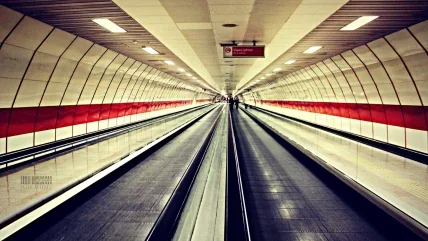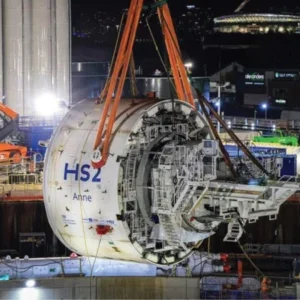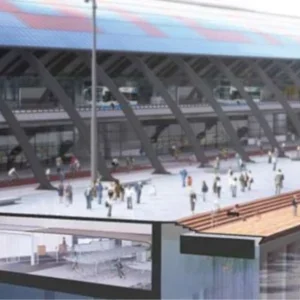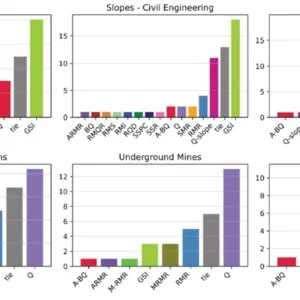
At 74.5km-long, the new Hizray underground metro project running from west to east through Istanbul is not only a major investment for the city and Turkey but also of global significance in its scale.
Hizray project is to include a total of 13 stations at 6km average intervals, two transition structures, and a major subsea crossing below the Bosphorous Strait. To be built at such scale between the European and Asian sides of the city, and running fully underground, through complex sedimentary geology of varied sandstones, claystones and limestones, the planning at this stage envisages 27 tunnel boring machines (TBMs) will be employed to build Hizray’s long tunnels.
Most of the TBMs are expected to be earth pressure balance (EPB) machines – 26 in total – for the majority of the Hizray route, running in twin 5.7m i.d. tunnels, to link stations from Beylikdüzü in the west to Sabiha Gökçen international airport, at Pendik, in the east. Approximately midway, where the route passes under the Bosphorous Strait, construction will change to a single 9.8m i.d. tunnel to be bored by a slurry TBM
Technical briefings on the project are the focus of a special session of UYAK 2023 (the 5th International Underground Excavations Symposium and Exhibition), to be held early March, (see box panel Istanbul Conference).
PLANNING AND PROCUREMENT
Hizray is being developed by Istanbul Metropolitan Municipality’s (IBB) Rail System Directorate. While the average distance between stations on most metros is around 1km, the authority aims to achieve fast travel over Hizray’s long distance route where the intervals are six times longer.
The most prominent issue during the design phase of Hizray was optimising the locations of the stations. Factors taken into account included population and urban density across city zones, forecasts of future travel demand, effective integration with the existing metro network, and to minimise travel time.
Hizray’s design objectives were established in pursuit of a feasible and realistic major metro project, as follows:
1. Use site investigation data from boreholes and geotechnical studies to determine excavation support and construction methodologies.
2. Consider required integrations, ownerships, land allocations, expropriations, site mobilisations, infrastructure conflicts, etc, where there may have been many difficult aspects. In addition, investigate energy use needs to determine the vertical alignment of the line where slopes will be travelled at high speeds, and what and where would be supporting auxiliary facility, etc. Studies continue.
3. Optimisation of tunnel size and operations, determination of vehicle parameters, parking scenarios, energy recycling, etc.
The design stages were carried out with the contractor and consultant companies in an interactive process with the feedbacks from the sector representatives. Work was carried out with industry representatives, suppliers and academy throughout the design phase.
Following this extensive preliminary design process, the procurement phase is to start in 2023. After commencement of major construction, IBB expects the project will take about seven years to complete and be commissioned.
INTEGRATION WITH OTHER LINES
Hizray Line, running west to east, from Beylikdüzü station, includes Nazim Hikmet station after crossing Küçükçekmece Lake to arrive at Halkali station, after which planned stations include Kirazli, Otogar, Kagithane and 4th Levent Stations. Thereafter, the line crosses below the Bosphorous Strait and stations beyond are Ümraniye, Mevlana, Sancaktepe, Kurtköy and then, finally, Sabiha Gökçen airport station.
By providing integration with other lines at all stations, Hizray will connect the city on an east-west axis. Having a small number of stations and design speed of 160 km/h (operating speed of approx 140 km/h), its entire length will be travelled in less than 54 minutes.
Hizray’s train services are to have two operating cycles – Full (between Sabiha Gökçen and Beylikdüzü stations) and Intermediate (Mevlana to Kirazli). Passenger demand is used to determine the intermediate loop. Both cycles have 290s. headways between trains. Thus, the headway between Mevlana and Kirazli stations, which are the joint operation stations of both cycles, is 145 seconds.
There is one surface depot, in Kurtköy area, and one underground depot, in Kirazli. Periodic and heavy maintenance of the vehicles is be done in Kurtköy, and only parking lines and washing lines are planned in Kirazli underground depot area.
GEOLOGY
Istanbul is a seismic area on tectonic plate boundaries and having been built at a major natural waterway its geology is sedimentary and complex. Hizray runs west-to-east through the city and crosses the waterway, and as such the geology is varied along the route.
Site investigation studies are ongoing but based on available information the sedimentary strata is as follows (west-to-east), at tunnel design depth:
West side (European) of project
From the west end of the project, proceeding eastward the geology is principally:
Beylikdüzü station to Halkali station:
? Sandstone and claystone (Gürpinar Member (Tdg) of Danismen Formation (Td) Halkali to Kirazli
station, and a short distance beyond:
? Sandstone and limestone (Ceylan Formation (Tc))
East of Kirazli to almost Otogar station:
? Sandstone and claystone (Gürpinar Member (Tdg))
Otogar and eastward, for a short distance:
? Clayey sand and clay (Çukurçesme Member (Tçç) & Güngören Member (Tçg) of Çekmece Formation (Tç))
Remaining distance to near Bosphorous:
? Siltstone, sandstone (Trakya Formation (Ct))
Central Area (Bosphorous Strait)
? Sandstone, claystone, some shale with calcite veins, and fossils (Kartal Member of Pencik Formation (Dpk));
East side (Asia) side of project
Continuing eastward from the Bosphorous Strait eastward, the geology proceeds as follows:
Initially:
? Limestone (Tuzla Limestone Member (DCdt) of Denizli Village Formation (DCd))
Remaining distance to Ümraniye station:
? Sandstone, claystone, some shale with calcite veins, and fossils (Kartal Member of Pencik Formation (Dpk));
Toward Finans Merkezi station, much of distance is:
? Limestone (Pelitli Formation (SDp)) Though a brief stretch of
? Siltstone, sandstone – Polonezköy Group’s (Op) Kurtköy Formation (Opk) with Bakacak Member (Opkb) and Kocotöngel Formation (Opkc), respectively.
Toward Melvana station and halfway to Sancaktepe station:
? Three types of siltstone and sandstone strata in member classifications (Kurtköy Formation (Opk) – Bakacak Member (Opkb), Süreyyapasa Member (Opks), Bakacak Member (Osa))
But mainly consists mainly of
? Limestone (Pelitli Formation (SDp))
From Sancaktepe station and halfway to Kurtköy station:
? Sandstone, claystone, some shale with calcite veins, and fossils (Kartal Member (Dpk))
For much of the remaining distance of the route eastward, it is mainly:
? Siltstone, sandstone (Süreyyapasa Member (Opks) Except for near Kurtköy station and a brief passage through
? Clayey sand (Sultanbeyli Formation (Ts)) And
? Siltstone, sandstone (Bakacak Member (Osa))
For more descriptive details of the geological strata see Box Panel 1 (Hizray: Geology)
UNDERGROUND STRUCTURES AND TUNNELLING
The project is to employ EPB machines mostly – 26 x EPBs – to bore approximately 130km, in total, of 5.7m i.d. single-track, parallel running tunnels. They approach the single larger tunnel under the Bosphorous via transition structures. After the transitions, each side of the strait will have a large TBM access shaft of more than 70m depth.
Other tunnelling works are planned for these twin tube sections of the project include New Austrian Tunnelling Method (NATM) excavations, as follows:
? Tail tunnel – (5.7m wide x 1km long)
? Turnout – (17.61m x 3.33km)
? Cross passage – main line – (5.7m x 8.16km)
? Cross passage – stations – (6.6m x 3.4km)
? Platform tunnels – (12m x 8.08km)
? Platforms connection tunnels – (9.24m x 3.32km)
? Inclined tunnels (stations) – (9.24m x 3.22km)
? Transition (at Bosphorous crossing) – (17.61m x 0.18km)
? Depot connection tunnel – (5.7m x 6.47km)
? Depot tunnel – (17.61m x 0.97km)
Bosphorous Crossing
While running in twin tube tunnels for the majority of its alignment, Hizray will pass under the strait in a single, larger diameter tunnel.
Transition structures will link the twin tunnels to the single larger tunnel. Prior tunnelling experience below the strait and knowledge of ground conditions in the area helped the planning and design studies to select the most suitable geological parameters for the transition structures.
Between the transition structures, the single tunnel covers a total distance of 3390m in the middle of Hizray.
Within this central section, the single twin-track tunnel passes under the strait for a distance of approximately 1580m, and its deepest point will be about 130m below sea level.
To cross under the strait, the most suitable tunnel section was determined after consultation with TBM manufacturers and tunnel specialist engineers with international experience. The discussions and studies led to a single tube as the preferred solution to various construction challenges, such difficulties with geology for cross passage construction under the strait, and also with regard to risk and consequence of malfunctions and maintenance needs that might occur while in the subsea section.
As a result of these studies, a 9.8m i.d. tunnel section was determined to be required, in accordance with NFPA standards and fire escape scenarios
HIZRAY: GEOLOGY
Geological profile – Legend Key, in more detail:
? Artificial fill (Yd): Varying colours, from clay to gravel size, with blocks and rubble in places, possibility of deepest uncontrolled fillings in airport area, elsewhere up to 10.5m occasionally but typical depth 1.5m-2m.
? Alluvium (Qal): grey/dark/light grey colours; fossils in places; clay, clayey sand and gravel.
? Sultanbeyli Formation (Ts): light to yellowish brown, light to very compact clayey sand and gravelly clayey sand units.
? Çekmece Formation (Tç): observed as Çukurçesme Member (Tçç) and Güngören Member (Tçg), consisting of yellowish brown, dark green (in places), medium to coarse grained clayey sand and clay units.
? Danismen Formation (Td) – Gürpinar Member (Tdg): light brown, fine-grained sand levels and light green, abundant carbonate clay levels. Claystone and sandstone levels are observed in the unit. Claystone units are grey-blackish grey, highly fractured, cracked and filled with calcite. The sandstones are greyish beige, fine-grained, fragmented in places.
? Ceylan Formation (Tc): beige, greenish grey coloured weak sandstone and white-beige weak limestone.
? Trakya Formation (Ct): grey/dark grey clay and grey/yellowish grey, weathered/moderately weathered siltstone, sandstone levels.
? Kartal Member of Pencik Formation (Dpk): yellowish brown, grey coloured, medium strength sandstone units and dark grey, less weathered, medium strength claystone levels. Shale unit is observed from place to place, dark grey with fine calcite veins, some fossils.
? Pelitli Formation (SDp): grey, moderately weathered, calcite-filled limestones.
? Yayalar Formation – Seyhli Member (OSys): brown – yellowish brown clayey sand levels and grey – light grey, hard, medium strength, slightly – moderately weathered claystone and limestone units.
? Polonezköy Group (Op) – Kurtköy Formation (Opk) – Süreyyapasa Member (Opks): of the purple, moderately weathered claystone – siltstone – sandstone levels and a grey – greenish grey, slightly – moderately weathered sandstone unit.
? Polonezköy Group (Op) – Kocatöngel Formation (Opkc): greenish grey, light grey, siltstone levels with occasional calcite fillings. Intermediate level sandstone units observed.
? Polonezköy Group (Op) – Kurtköy Formation (Opk) – Bakacak Member (Opkb): siltstone and sandstone units. The siltstone units are brownish purple and moderately weathered. The sandstone units are greenish grey and locally filled with calcite. In places, sandstone levels contain silica.
? Dyke unit (Dk): greenish gray, less weathered, moderately resistant, contains pyrite crystals.






